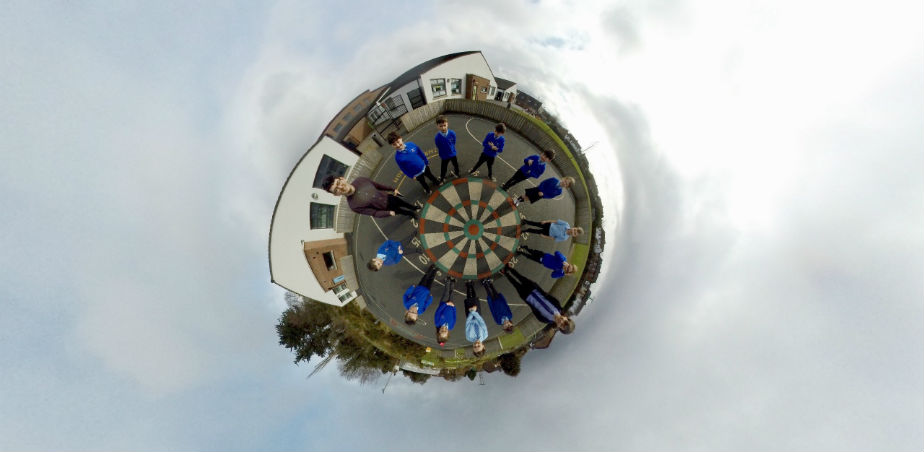Blog 2 – Chris McCambridge, Special Educational Needs Teacher, Virtually There

Pupils from St Colman's Bann PS - Virtually There Project
 Christopher McCambridge is a Special Educational Needs teacher at St. Colman’s Primary School, Lambeg. St. Colman’s Primary is a mainstream school of 400 pupils with two learning support unit classes. Christopher is also an active member of the Belfast art scene. He co-founded the arts organisation Belfast Platform for the Arts (Platform Arts) in 2010, which continues to provide an exhibition space and studios for artists.
Christopher McCambridge is a Special Educational Needs teacher at St. Colman’s Primary School, Lambeg. St. Colman’s Primary is a mainstream school of 400 pupils with two learning support unit classes. Christopher is also an active member of the Belfast art scene. He co-founded the arts organisation Belfast Platform for the Arts (Platform Arts) in 2010, which continues to provide an exhibition space and studios for artists.
In 2016 Christopher and his Primary 6/7 class were chosen to take part in the Kids’ Own Publishing Partnership ‘Virtually There’ project. ‘A virtual artist in residence project which explores the potential for creative engagement between artists working from their studio and children and teachers in the classroom using video conferencing technology’. (Orla Kenny, Creative Director of Kids’ Own Publishing Partnership). Now in their 2nd year, artist John D’Arcy has been working collaboratively with Christopher and his class at St Colman’s P.S as virtual artist-in-residence.
Art as a Gateway
A recent article in the Guardian newspaper, discussed the importance of prehistoric art. In particular, that of the Neanderthals and Homo sapiens. The art critic, Jonathan Jones, was examining the significance of the findings that Neanderthals had painted on cave walls in Spain 65,000 years ago, tens of thousands of years before Homo sapiens. The Neanderthal artwork in question was a stencilled red ochre handprint on rock. It wasn’t the discussion about whether or not Neanderthals were the first true artists or if this honour should belong to another early human species, Homo erectus, or because of the quality of the representational artwork by Homo sapiens, they should be considered the first ‘true’ artists, that piqued my interest, it was the significance that art had on moulding a species. That ‘art’ constituted the beginnings of intelligence, the “capacity to imagine and dream” and within our own species Homo sapiens “the birth of the complex cathedral of the modern mind … [opening] the way, in modern human history, to everything from writing to computers” (Jonathan Jones, 2018). – read the full article www.theguardian.com/artanddesign/2018/feb/23/neanderthals-cave-art-spain-astounding-discovery-humbles-every-human
Within the education sector, the Northern Ireland Curriculum has been developed to cater for all subjects, allowing children access to a varied education. The reality is, that as children progress through primary school, teachers can be under pressure delivering the curriculum, often focussing on the areas of numeracy and literacy to the detriment of other curricular areas, particularly art. This can be evident in Primary 6 and the first term of Primary 7, when a substantial amount of time is spent preparing the children for the GL and AQE transfer tests. These pressures can sometimes be self-imposed, a teacher perhaps feeling that it is important for the children to develop these skills and after the tests have been completed, delivering those other areas or perhaps they can be pressures by other stake-holders within the school community. Regardless of this, the Guardian article reinforced my own view that Art should be on-a-par with those supposedly ‘key subjects or areas.’ If, works of art have been “held up as proof of the cognitive superiority of modern humans,” this should mean that art can play an important role in the curriculum.
As a Special Educational Needs teacher, teaching Primary 6/7 pupils, the pressures of the GL and AQE tests are not applicable to the children that I teach. Like all primary teachers the delivery of the Northern Ireland Curriculum is still essential. However, without these testing constraints, there is an opportunity to embed art throughout the curriculum to a greater extent. It does not need to simply be an add on or linked to a world around us topic. My project work with Kids’ Own has been successful in facilitating this. As I detailed in my last post, I am now in my second year of working within the Kids’ Own project and in-particular working with the artist John D’arcy.
At the beginning of Year 2, we set about choosing a word that would encompass everything. The word we chose was Hacking. This would be the jumping off point, from which all mini-projects or lessons would stem from. John and I found that this liberated our planning, allowing for greater flexibility. When we discussed the word with the children, it ignited their enthusiasm, prompting new avenues of learning that John and I had not previously considered.
Throughout the Hacking project, we have included aspects of numeracy and literacy. A particular favourite being a session exploring ‘codes and language’. This session included: Semaphore, Morse code, the phonetic alphabet, emoji’s and Makaton. After the session had been completed, I was amazed to see children with difficulties in sequencing the alphabet testing one another on the use of Makaton and the symbol to letter correspondence. The project has also allowed the children to develop their creativity and problem-solving skills. They have become more expressive when discussing topics, themes or their own work. This has had an impact in other avenues such as their social and emotional well-being.
I began this post, examining the importance that art had on our evolution as a species. So, I feel it is relevant to question, if it had such a bearing on our evolution, then why can it not have the same impact upon our education of young children?